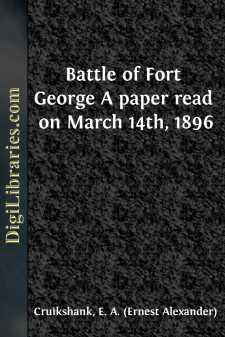Categories
- Antiques & Collectibles 13
- Architecture 36
- Art 48
- Bibles 22
- Biography & Autobiography 813
- Body, Mind & Spirit 138
- Business & Economics 28
- Children's Books 12
- Children's Fiction 9
- Computers 4
- Cooking 94
- Crafts & Hobbies 4
- Drama 346
- Education 46
- Family & Relationships 57
- Fiction 11821
- Games 19
- Gardening 17
- Health & Fitness 34
- History 1377
- House & Home 1
- Humor 147
- Juvenile Fiction 1873
- Juvenile Nonfiction 202
- Language Arts & Disciplines 88
- Law 16
- Literary Collections 686
- Literary Criticism 179
- Mathematics 13
- Medical 41
- Music 40
- Nature 179
- Non-Classifiable 1768
- Performing Arts 7
- Periodicals 1453
- Philosophy 64
- Photography 2
- Poetry 896
- Political Science 203
- Psychology 42
- Reference 154
- Religion 505
- Science 126
- Self-Help 81
- Social Science 81
- Sports & Recreation 34
- Study Aids 3
- Technology & Engineering 59
- Transportation 23
- Travel 463
- True Crime 29
Battle of Fort George A paper read on March 14th, 1896
Categories:
Description:
Excerpt
For about a quarter of a century Niagara was the principal town and commercial capital of Western Canada, and for a brief period was actually the seat of government for the Upper Province. The removal of the provincial officers to York in 1796 struck the first blow at its supremacy, but its material prosperity continued until the beginning of the war with the United States when its exposed situation subjected it to a series of calamities which culminated in its total destruction on the 10th of December, 1813.
During that time many travellers of more or less note visited the place at short intervals on their way to or from the Falls, and a considerable number of them have recorded their observations. Patrick Campbell in 1791, D'Arcy Bolton in 1794, the Duke de Rochefoucauld Liancourt in 1795, Isaac Weld and J. C. Ogden in 1796, John Maude in 1800, George Heriot in 1806, Christian Schultz in 1807, John Melish in 1810 and Michael Smith in 1812 have described the town and adjacent country at considerable length from various points of view. Other accounts are to be found in the National Intelligencer newspaper published at Washington, D. C., in 1812, and in Smith's Gazetteer of Upper Canada for 1813. From these numerous sources it would seem an easy task to form a fairly correct estimate of the appearance of the town, its commercial importance and the character of the inhabitants.
THE TAKING OF FORT GEORGE.
It is described as being nearly a mile square, sparsely built, with many pasture fields, gardens, orchards and open spaces interspersed among the houses. Smith, an American resident of the province now was expelled in 1812 for having declined to take oath of allegiance, states that there were "several squares of ground in the village adorned with almost every kind of precious fruit." According to the same authority it contained two churches—one of them built of stone, a court house and jail, an Indian council house, an academy in which Latin and Greek were taught by the Rev. John Burns a Presbyterian minister, a printing house, six taverns, twenty stores and about a hundred dwelling houses, many of them described as "handsome buildings of brick or stone, the rest being of wood, neatly painted." From the lake the town is said to have made an "imposing appearance" as most of the buildings fronted the water. Smith concludes his account with the remark that it was "a beautiful and prospective place, inhabited by civil and industrious people." Dr. John Mann, a surgeon in the United States army who accompanied the invading forces and afterwards wrote the "Medical History of the War," styles it "a delightful village." The population was probably underestimated at five hundred exclusive of the regular garrison of Fort George, usually numbering about two hundred men. The names of John Symington, Andrew Heron, Joseph Edwards, John Grier, John Baldwin and James Muirhead have been recorded as some of the principal merchants.
An open plain or common of nearly a mile in width separated the town from Fort George. This post was described by the Governor General in the early summer of 1812, in official report on the defences of Upper Canada as an irregular fieldwork consisting of six small bastions faced with framed timber and plank, connected by a line of palisades twelve feet high, and surrounded by a shallow dry ditch. Its situation and construction were alike condemned as extremely defective. Although it partially commanded Fort Niagara it was in turn overlooked and commanded by the high ground on the opposite side of the river near Youngstown....


